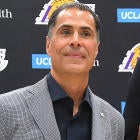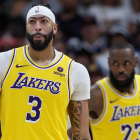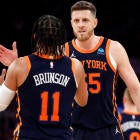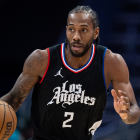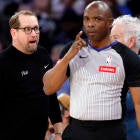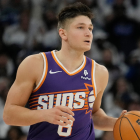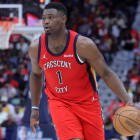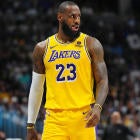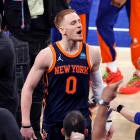
Kawhi Leonard held Rob Pelinka hostage in 2019. The superstar's week-long flirtation with the Lakers had the possibly intentional effect of handicapping their offseason flexibility. By the time he informed them that he planned to become a Clipper, most of the best free agents on the market were gone. Left for their cap space was a collection of flawed role players, holdovers from the Magic Johnson era and high-risk home run swings.
Pelinka took those lemons and made lemonade. Players like Danny Green, JaVale McGee and Rajon Rondo might not have been ideal, but they were enough. LeBron James and Anthony Davis heal all wounds. The Lakers won a championship with two superstars and spare parts. Pelinka received little credit for that result. He finished seventh in Executive of the Year voting for his efforts. The perceived snub held a shred of merit. Davis wanted to be a Laker. The limited market made most of Pelinka's choices for him. He helmed a champion, but didn't exactly build one.
The 2020 market proved a far greater test of Pelinka's creativity as an executive. He didn't have to gift the rest of the league a week-long head start. This time, there would be no superstar-induced hiatus, and that left him the freedom to strike quickly.
The Lakers made the very first trade of the offseason by acquiring Dennis Schroder from the Oklahoma City Thunder. In a single stroke, Pelinka solved the problem that vexed the Lakers offense all season. When LeBron James went to the bench, the Lakers fell from an excellent offensive team (112.1 points per 100 possessions) to a below-average one (105.2). Now they have the Sixth Man of the Year runner-up, a speedster at point guard to keep the offense humming when James rests. In a condensed season, that's going to happen more than usual.
Getting Schroder cost the Lakers Danny Green. Pelinka didn't wait long to replace him, either. One of the first signings of free agency was a one-year, $3.6 million deal for Wesley Matthews. At less than a quarter of Green's price, the Lakers landed an alternative who shot only 0.3 percent worse from behind the arc and rated better by both ESPN's Defensive Real Plus-Minus and Basketball Index's D-PIPM metrics last season. Let's say the two are roughly even, with Green perhaps holding a slight edge based on track record. The Lakers added Schroder for a marginal downgrade and a first-round pick that was unlikely to contribute next season anyway. Two moves. Two slam dunks.
Addition No. 3 was the confusing one. Sixth Man of the Year winner Montrezl Harrell isn't a clean fit with the Lakers. He's a non-shooter and questionable defender that got eviscerated by Nikola Jokic in the postseason. More bench scoring and energy was certainly welcome, but it hardly should have been the priority. Harrell's best trait is his work as a pick-and-roll finisher. Nobody in the NBA does that better than Davis. James-led teams need shooting and defense. That was the presumed opportunity cost of paying Harrell. By spending their full non-taxpayer mid-level exception on what likely amounted to a luxury, the Lakers had seemingly deprived themselves the opportunity to fill that 3-and-D hole at center with someone like, say, Marc Gasol.
But Pelinka knew something that the rest of the basketball world did not: Gasol, 35 years old and coming off a max contract, was comfortable playing for the minimum. Fitting him under the hard cap took some tricky cap gymnastics. Gasol was already leaving money on the table, so his request for a player option and the higher cap number that came with it was more than justifiable. So Pelinka cleared the space by trading JaVale McGee to Cleveland, and suddenly, the entire frontcourt clicked into place.
Gasol will presumably start at center in the role once occupied by McGee, whose inconsistency and limitations cost him his place in the rotation when the playoffs arrived. The Lakers may have had the best pick-and-roll finisher in basketball, but could scarcely use him early in games because McGee clogged the paint. Gasol, an admittedly hesitant shooter, drilled 38.5 percent of his 3-point attempts last season. Stick him at the top of the arc and James and Davis can suddenly unleash their fourth-quarter finishing move right from the opening tip. The Lakers ran among the fewest pick-and-rolls in basketball last season. Now, they have the spacing to do so all game, and a reserve duo in Schroder and Harrell that can spam it to death against helpless bench units.
In a sense, Gasol doesn't just replace McGee. He replaces elements of Rondo's postseason contributions as well. No, he isn't a guard, but he is a longtime favorite of LeBron's because of his basketball IQ. Jokic is cut from the same cloth. Gasol's career average of 3.4 assists per game tops any center James has ever played with. His presence will encourage off-ball movement in a starting five that was often stagnant last season, and that IQ will manifest itself defensively as much as it will on offense.
Gasol won the 2013 Defensive Player of the Year. While his mobility is largely gone, his brilliant basketball mind is as sharp as ever. He will be in the right place at the right time, and that radius will be a fairly limited one. The Lakers can afford to handcuff Gasol to the basket defensively if they need to. Davis covers more than enough ground for both of them. With Dwight Howard gone, Gasol fills in as a low-post defender for the matchups in which one would be required. He's an upgrade in that department as well. Should the Lakers draw Jokic again in the playoffs, Gasol will contain him.
The Harrell signing, individually, was a head-scratcher. He presented a redundancy to Davis on one end and a liability he'd need to cover on the other. But in concert with the Gasol addition? It's a masterstroke, one that gives the Lakers two wildly different kinds of centers that they can mix and match as opponents dictate and a 26-year-old that could conceivably be part of the team for years to come. Harrell gets to remain in the bench role on which he thrived as a Clipper, and Davis, with two such highly-regarded centers on the roster, can retain his preferred power forward spot almost exclusively during the regular season.
Virtually every player in the rotation can now claim similar comfort in their role. Harrell has always been at his best coming off the bench. Now the Lakers can keep him their guilt-free and pair him with Davis to limit his defensive shortcomings. LeBron can start at point guard, but if he needs some off-ball rest, Schroder can run the offense. If the re-signed Kentavious Caldwell-Pope proves more comfortable returning to the bench position he held for most of the regular season? Schroder can fill in for him as a starter, too. So can Alex Caruso, a starter in the Finals clincher. Nobody on this roster needs to be pigeonholed. The things that worked last season will work again this season. The things that didn't have largely been addressed. There is enough raw talent to spend the regular season tinkering with roles and rotations to find the most cohesive whole.
And if Pelinka isn't satisfied with the finished product? He's left himself several outs. Last season's salary structure made a meaningful in-season trade almost impossible. Every major salary on the roster was integral to the rotation. Even if they had the money, the Stepien Rule prevented them from trading any future first-round picks. But with Schroder and Harrell on short-term contracts totaling almost $25 million and their 2027 first-round pick technically tradable now, thanks to the seven-year rule, a bigger in-season move is on the table if it's needed. It probably won't be, but never say never.
There are minor holes to poke. The Lakers don't (yet) have a deadeye 3-point shooter. They could use a(nother) big wing defender, both to throw at players like Leonard and Kevin Durant in the playoffs and to enable switchier lineups when matchups call for them. The closing lineup isn't set in stone. This isn't a perfect roster. They aren't the 2017 Warriors.
Still, they are a genuine improvement upon a defending champion, something of a rarity in a league usually designed to rein in existing winners. These Lakers are younger and deeper than the 2020 version. They fit better with one another. They're more talented not only than their previous selves, but perhaps any team that LeBron has ever played for.
It's proof of what Pelinka is capable of when he isn't being sabotaged by a rival player. A year ago, he manufactured a champion around James and Davis off the scrap heap. His reward was that seventh-place Executive of the Year finish. Without the constraints of a Kawhi chase limiting him, he's built a substantially better team this time around, and when that team is rampaging through the NBA in a few months, hopefully his peers will have an easier time recognizing the work he's done in constructing a possible juggernaut this time around.













